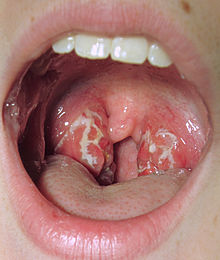
Back التهاب البلعوم بالعقديات Arabic Streptokokk faringit Azerbaijani ایسترپتوکوککال بوغاز آغریسی AZB Стрептококов фарингит Bulgarian স্ট্রেপটোকোকাল ফ্যারিঞ্জাইটিস Bengali/Bangla Faringitis estreptocòccica Catalan ھەوکردنی قورگ CKB Streptokoková faryngitida Czech Streptokokkenangina German Στρεπτοκοκκική φαρυγγίτιδα Greek
| Streptococcal pharyngitis | |
|---|---|
| Other names | Streptococcal sore throat, strep throat |
 | |
| A culture positive case of streptococcal pharyngitis with typical tonsillar exudate in a 16-year-old | |
| Specialty | Infectious disease |
| Symptoms | Fever, sore throat, enlarged lymph nodes[1] |
| Usual onset | 1–3 days after exposure[2][3] |
| Duration | 7–10 days[2][3] |
| Causes | Group A streptococcus[1] |
| Risk factors | Sharing drinks or eating utensils[4] |
| Diagnostic method | Throat culture, strep test[1] |
| Differential diagnosis | Epiglottitis, infectious mononucleosis, Ludwig's angina, peritonsillar abscess, retropharyngeal abscess, viral pharyngitis[5] |
| Prevention | Handwashing,[1] covering coughs[4] |
| Treatment | Paracetamol (acetaminophen), NSAIDs, antibiotics[1][6] |
| Frequency | 5 to 40% of sore throats[7][8] |
Streptococcal pharyngitis, also known as streptococcal sore throat (strep throat), is pharyngitis (an infection of the pharynx, the back of the throat) caused by Streptococcus pyogenes, a gram-positive, group A streptococcus.[9][10] Common symptoms include fever, sore throat, red tonsils, and enlarged lymph nodes in the front of the neck. A headache and nausea or vomiting may also occur.[11] Some develop a sandpaper-like rash which is known as scarlet fever.[2] Symptoms typically begin one to three days after exposure and last seven to ten days.[2][3][11]
Strep throat is spread by respiratory droplets from an infected person, spread by talking, coughing or sneezing, or by touching something that has droplets on it and then touching the mouth, nose, or eyes. It may be spread directly through touching infected sores. It may also be spread by contact with skin infected with group A strep. The diagnosis is made based on the results of a rapid antigen detection test or throat culture. Some people may carry the bacteria without symptoms.[11]
Prevention is by frequent hand washing, and not sharing eating utensils.[11] There is no vaccine for the disease.[1] Treatment with antibiotics is only recommended in those with a confirmed diagnosis.[12] Those infected should stay away from other people until fever is gone and for at least 12 hours after starting treatment.[1] Pain can be treated with paracetamol (acetaminophen) and nonsteroidal anti-inflammatory drugs (NSAIDs) such as ibuprofen.[6]
Strep throat is a common bacterial infection in children.[2] It is the cause of 15–40% of sore throats among children[7][13] and 5–15% among adults.[8] Cases are more common in late winter and early spring.[13] Potential complications include rheumatic fever and peritonsillar abscess.[1][2]
- ^ a b c d e f g h "Is It Strep Throat?". CDC. October 19, 2015. Archived from the original on 2 February 2016. Retrieved 2 February 2016.
- ^ a b c d e f David A.Warrell, Timothy M. Cox, John D. Firth, eds. (2012). Oxford textbook of medicine infection. Oxford: Oxford University Press. pp. 280–281. ISBN 978-0-19-163173-3. Archived from the original on 2016-10-10.
- ^ a b c Goroll AH, Mulley AG Jr (2009). Primary care medicine: office evaluation and management of the adult patient (6th ed.). Philadelphia: Wolters Kluwer Health/Lippincott Williams & Wilkins. p. 1408. ISBN 978-0-7817-7513-7. Archived from the original on 2016-09-15.
- ^ a b "Strep throat - Symptoms and causes". Mayo Clinic. Retrieved 24 January 2020.
- ^ Cite error: The named reference
Got2018was invoked but never defined (see the help page). - ^ a b Weber R (March 2014). "Pharyngitis". Primary Care. 41 (1): 91–8. doi:10.1016/j.pop.2013.10.010. PMC 7119355. PMID 24439883.
- ^ a b Shaikh N, Leonard E, Martin JM (September 2010). "Prevalence of streptococcal pharyngitis and streptococcal carriage in children: a meta-analysis". Pediatrics. 126 (3): e557–64. doi:10.1542/peds.2009-2648. PMID 20696723. S2CID 8625679.
- ^ a b Shulman ST, Bisno, AL, Clegg, HW, Gerber, MA, Kaplan, EL, Lee, G, Martin, JM, Van Beneden, C (Sep 9, 2012). "Clinical Practice Guideline for the Diagnosis and Management of Group A Streptococcal Pharyngitis: 2012 Update by the Infectious Diseases Society of America". Clinical Infectious Diseases. 55 (10): e86–102. doi:10.1093/cid/cis629. PMC 7108032. PMID 22965026.
- ^ "ICD-11 for Mortality and Morbidity Statistics". icd.who.int. Retrieved 21 December 2022.
- ^ "Pharyngitis (Strep Throat): Information For Clinicians | CDC". www.cdc.gov. 19 December 2022. Retrieved 20 December 2022.
- ^ a b c d "Is your sore throat strep?". Centers for Disease Control and Prevention. 2 November 2022. Retrieved 21 December 2022.
- ^ Harris AM, Hicks LA, Qaseem A (19 January 2016). "Appropriate Antibiotic Use for Acute Respiratory Tract Infection in Adults: Advice for High-Value Care From the American College of Physicians and the Centers for Disease Control and Prevention". Annals of Internal Medicine. 164 (6): 425–34. doi:10.7326/M15-1840. PMID 26785402.
- ^ a b Choby BA (March 2009). "Diagnosis and treatment of streptococcal pharyngitis". Am Fam Physician. 79 (5): 383–90. PMID 19275067. Archived from the original on 2015-02-08.